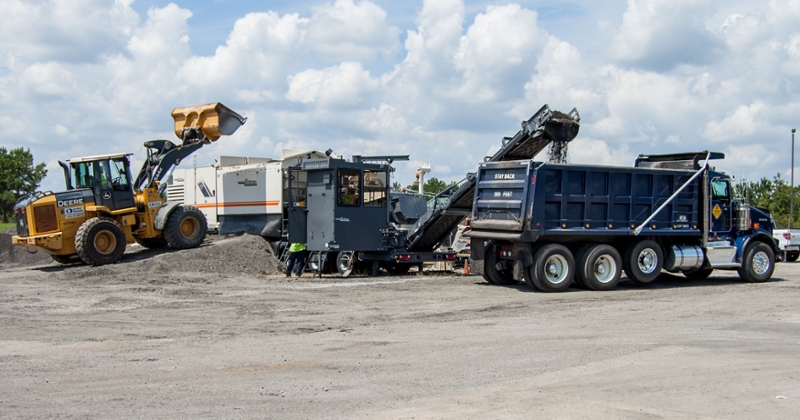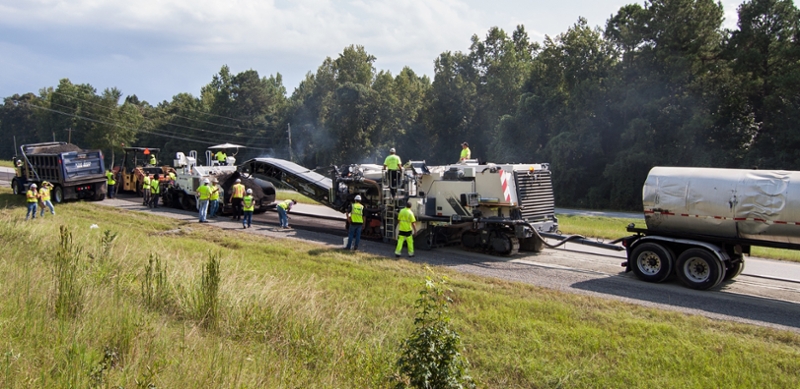- Spring 2018
Cold Recycling of Asphalt Pavements
Over the years, asphalt has become the material of choice for constructing environmentally friendly pavements. Asphalt continues to be reclaimed and reused more than any other product in the United States, and cold asphalt pavement recycling takes sustainability one step further. As its name implies, cold recycling is an asphalt pavement rehabilitation method without the application of heat during the construction process. This economical technique is not only effective in eliminating rutting and cracking distresses of asphalt pavements, but also conserves non-renewable resources and energy.
Cold recycling includes two subcategories, i.e., cold in-place recycling (CIR) and cold central-plant recycling (CCPR). Typically performed using a “train” of equipment, CIR occurs on the roadway in a continuously moving process that recycles 100% of the existing asphalt pavement. CCPR is a process in which the asphalt recycling takes place at a central location using a stationary cold mix plant. Cold recycling usually requires multiple additives, including bituminous material (e.g., foamed or emulsified asphalt binder), chemical additives (e.g., lime, cement, or fly ash), and water. A job mix formula defines the RAP gradation and the percentages of each of the additives for cold recycled asphalt mixtures. Due to the high void content of cold recycled asphalt mixtures, a surface course is required to protect the mixture from the intrusion of surface moisture. Asphalt overlays are typically used for pavements with high traffic volumes, while chip seals, slurry seals, and micro surfacing may be used for pavements with low traffic volumes.

CCPR combines RAP with foamed or emulsified asphalt in a central production plant without the application of heat.

CIR involves the same process as CCPR but takes place on the roadway using a train of equipment.
In 2011, the Virginia Department of Transportation (VDOT) reconstructed a 3.7-mile section on Interstate 81 (I-81) involving both CIR and CCPR techniques. Table 1 provides the pavement structures of the cold recycling test section on I-81. As of spring 2018, the left lane has carried approximately 3.3 million equivalent single axle loads (ESALs) and the right lane sections have carried approximately 13 million ESALs. As of June 2017, the left lane has an International Roughness Index (IRI) of 53 inches per mile and 0.1-inch rut depth, and the right lane has an IRI of 44 inches per mile and 0.08-inch rut depth. These results demonstrate that both CIR and CCPR perform superbly in high traffic applications. In addition to the environmental benefits, this cold recycling project saved VDOT and taxpayers millions of dollars by reusing existing resources.
Table 1 Pavement Structures of VDOT Cold Recycling Test Section on I-81
In 2012, VDOT sponsored three instrumented test sections at the NCAT Test Track to further study CCPR pavements under high truck traffic conditions. The project was executed in coordination with the Virginia Transportation Research Council (VTRC). Table 2 shows the pavement structures of the cold recycling test sections at the track. After 19 million ESALs of trafficking, these three sections have shown excellent performance with no cracking distress observed, rut depths less than 0.3-inches, and ride quality remaining nearly unchanged. The structural characterization indicates that the layer coefficients of cold recycled asphalt mixtures range from 0.36 to 0.44. This study, Structural Study of Cold Central Plant Recycling Sections at the National Center for Asphalt Technology (NCAT) Test Track, was selected by AASHTO as a “Sweet Sixteen” project for 2017. The Sweet Sixteen program is administered by the Value of Research Task Force in AASHTO to identify and promote sixteen projects per year (four from each AASHTO Region) that are considered to be high-value research. Dr. Brian Diefenderfer (VTRC), Miguel Diaz (NCAT Ph.D. graduate student), Dr. David Timm (AU Civil Engineering), and Dr. Benjamin Bowers (VTRC) authored the report selected for the Sweet Sixteen.
Table 2 Pavement Structures of Cold Recycling Test Sections at the NCAT Test Track
In 2015, NCAT constructed four test sections on US 280 in Lee County, Alabama to evaluate the field performance of cold recycled asphalt pavements under thinner surface layers. These sections included CCPR with emulsified binder and with foamed binder, and CIR with emulsified binder and with foamed binder. The four-inch cold recycled layers were surfaced with a one-inch Superpave mix. As of 2018, the four test sections have carried over 2.0 million ESALs with rut depth less than 0.25-inches.
In 2017, NCAT prepared two AASHTO provisional standards for cold recycling mix design, which have been approved by the AASHTO Subcommittee on Materials. These standards specify the minimum quality requirements to produce a job mix formula for cold recycled asphalt and document the procedures to determine its optimum asphalt content.
Cold recycling is a leading technology in structural road rehabilitation that reuses existing resources and reduces project time. The field experience from VDOT and NCAT shows that this technology is not only suitable for low and medium traffic volume roadways but is also applicable to high traffic volume pavements. The recent success achieved by VDOT and NCAT is expected to promote the application of cold recycling technology to high traffic volume pavements nationally.